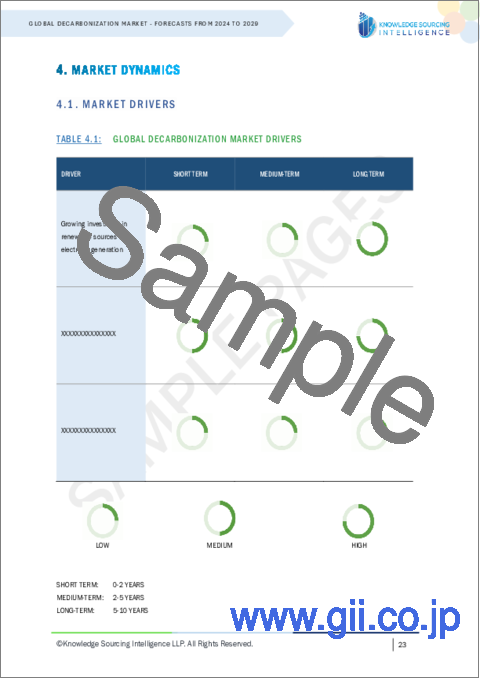|
|
市場調査レポート
商品コード
1425086
脱炭素化の世界市場:予測(2024年~2029年)Global Decarbonisation Market - Forecasts from 2024 to 2029 |
||||||
カスタマイズ可能
|
|||||||
| 脱炭素化の世界市場:予測(2024年~2029年) |
|
出版日: 2024年01月24日
発行: Knowledge Sourcing Intelligence
ページ情報: 英文 148 Pages
納期: 即日から翌営業日
|
全表示
- 概要
- 目次
脱炭素化市場は予測期間中にCAGR10.11%で成長すると予測されます。
気候変動対策に不可欠なプロセスである脱炭素化には、輸送、産業、エネルギー生産など多様な排出源からの二酸化炭素排出を削減または排除することが含まれます。2050年までにネットゼロの世界経済を達成するという野心的な目標は、既存技術と新興技術の両方を活用すれば、技術的にも経済的にも確かに達成可能です。しかし、その実現には、エネルギー生産と消費のパターンを大幅に転換する必要があります。その結果、脱炭素化は企業トップ(C-suite)のアジェンダの中で重要な位置を占めるようになり、一方で、二酸化炭素に対する意識が高まる市民社会に後押しされ、法的枠組みが急速に進化しています。気候変動をめぐる議論には、しばしば2つの一見逆説的な概念が含まれています。一方では、完全かつ迅速な脱炭素化を達成するという課題は、産業革命以前の水準と比較して、地球温暖化を摂氏2度未満に抑えるという喫緊の課題とともに、途方もなく困難であるように見えます。その一方で、事態の深刻さを考えれば、このような迅速な脱炭素化への取り組みは避けて通れない必須事項です。ネット・ゼロの目標達成に向けた脱炭素化の重要な役割を理解するためには、データの作成と活用が不可欠です。ネット・ゼロのためのデータというコンセプトは、複雑な炭素評価を実行可能な洞察に変換する重要なツールとして浮上します。信頼性の高いデータとAIプラットフォームに支えられた工業化された測定技術を導入することで、組織はESG(環境、社会、ガバナンス)コミットメントを大規模に効果的にモニタリングし、報告することができます。今後、脱炭素イニシアチブを大規模に効果的に実行するためには、多様な専門知識を持つ外部パートナーとの協業が必要です。
イントロダクション
脱炭素化市場は、二酸化炭素排出量の削減と低炭素社会への移行に向けた経済的・ビジネス的側面を中心に展開される複雑でダイナミックな市場です。気候変動を緩和する緊急の必要性から生じる多くの機会と課題を包含しています。この市場の特徴は、ネット・ゼロ・エミッションの達成に向けた様々な企業や政府のコミットメントが高まっていることであり、持続可能な慣行や技術の育成を目指した活動やイノベーションが急増しています。この市場において、企業は環境に積極的に貢献するだけでなく、競合情勢の中で差別化を図るチャンスも与えられています。グリーン製品や持続可能な価値提案を取り入れることで、企業はより大きな市場シェアを獲得し、環境にやさしい代替品に対する需要の高まりに応えて、価格プレミアムを獲得できる可能性があります。さらに、既存のビジネスモデルを脱炭素化するプロセスは、価値向上の重要な原動力として浮上しており、多くの企業が、より持続可能な慣行に合わせて事業の再構築に投資するよう促しています。世界の脱炭素化推進への機関投資家の関与は顕著な傾向となっており、炭素クレジットや関連プロジェクトへの投資は、低炭素経済への移行を支援・加速する手段として機能しています。さらに、炭素排出枠の概念は、特に気候変動対策が遅れるシナリオや迅速に実施されるシナリオにおいて、財務的な安全性を提供し、全体的な投資リターンを向上させる可能性があるとして、支持を集めています。従って、脱炭素化は、環境上の必須課題であると同時に、様々な気候変動シナリオの可能性の中で、企業が長期的な競争力と回復力を確保するための戦略的機会でもあります。
促進要因
- エネルギー効率:エネルギー効率は、脱炭素化の包括的な追求における基本的な柱であり、特に予見可能な将来において、コスト効率の高い方法で温室効果ガスの排出を効果的に抑制できる多面的なアプローチとして認識されています。脱炭素化イニシアチブの包括的な範囲は、建物、運輸、産業運営を含むがこれらに限定されない様々なセクターにおけるエネルギー効率の強化に協調的に焦点を当てることを包含します。エネルギー消費慣行を体系的に改善し、持続可能な技術を導入することで、二酸化炭素排出量を大幅に削減し、世界の発展にとってより持続可能な軌道を促進することを目指しています。
- 産業電化:二酸化炭素排出量の削減を追求するためには、送電網と自家発電の組み合わせによる低炭素電力の最新の進歩を利用することが不可欠です。この戦略的アプローチは、さまざまな重要戦略を含む脱炭素化という広範なミッションにおいて極めて重要です。そのような戦略のひとつに、誘導加熱、放射加熱、または先進的なヒートポンプの利用によるプロセス熱の電化があり、従来の燃料ベースの加熱方法への依存を効果的に最小化します。さらに、脱炭素化の推進には、特に鉄鋼やセメント製造などの産業で普及している高温域プロセスの電化も必要であり、これによって従来の高温生産技術に伴う大幅なカーボンフットプリントを抑制することができます。
- 低炭素燃料、原料、エネルギー源:脱炭素化への取り組みは、喫緊の課題である気候変動への対応において極めて重要です。温室効果ガス排出の悪影響を緩和するため、低炭素代替物の利用を重視した様々な戦略が採用されています。これらの代替案は、水素、バイオ燃料、合成燃料を既存のエネルギー枠組みに統合することで、従来の高炭素エネルギー源への依存を減らすなど、さまざまな選択肢を包含しています。さらに、低炭素原料、特にバイオマスの採用は、持続可能なソリューションとして勢いを増しています。さらに、風力、太陽光、地熱などの再生可能エネルギーを取り入れることは、持続可能で環境に優しい実践を追求する上での基本的な柱となります。これらの対策を優先することで、産業界や社会は、炭素排出を抑制し、より持続可能な未来を促進するための世界の取り組みに積極的に貢献しています。
- 炭素回収・利用・貯留(CCUS):炭素回収・利用・貯留(CCUS)技術は、深刻化する気候変動の脅威に対抗するための重要な手段として浮上してきました。さまざまな産業プロセスから排出される二酸化炭素を回収する能力を持つこれらの技術は、温室効果ガスの排出を効果的に緩和するための、実行可能な道筋を示しています。これらの排出物を捕捉して地下に閉じ込めることができるだけでなく、石油回収を促進するために利用することもできます。二酸化炭素排出量を削減するための世界の取り組みが強化されるにつれ、CCUS技術の統合は、より広範な脱炭素化戦略の極めて重要な要素となっています。その結果、産業部門におけるCCUSの広範な採用がますます重視されるとともに、CCUS新技術の進歩・革新に向けた熱心な取り組みが行われています。
- グリーンファイナンスとカーボンプライシングメカニズムグリーンボンドやローンなどさまざまな金融商品を含むグリーンファイナンスは、環境に配慮した取り組みに資金を集中させ、より持続可能な経済活動への転換を促進します。さらに、炭素税やキャップ・アンド・トレード制度を含む炭素価格決定メカニズムは、炭素排出量に金銭的価値を付与し、企業にカーボンフットプリントの社会的コストを内部化させます。こうした金融ツールをより広範な経済的枠組みに組み込むことで、企業は環境に優しい慣行を積極的に取り入れるインセンティブを与えられ、最終的には、より環境意識の高い、責任あるビジネス環境が育まれることになります。
主要企業が提供する製品
- Atosは、エネルギー効率化ソリューション、再生可能エネルギーソリューション、炭素回収・貯留ソリューションなど、さまざまな脱炭素技術を提供しています。Atosは、顧客に代わって脱炭素ソリューションの導入と運用を管理することができます。
- BVは、エネルギー効率化ソリューション、再生可能エネルギーソリューション、炭素回収・貯留ソリューションなど、さまざまな脱炭素技術を提供しています。BVは、顧客が脱炭素化戦略を策定し、実行するのを支援します。これには、カーボンフットプリントの特定、目標の設定、目標達成計画の策定などが含まれます。
脱炭素化市場における石油・エネルギー分野の著しい成長:
脱炭素化市場は石油・エネルギー分野に大きな影響を与え、様々な結果や需要をもたらすと予想されます。主な影響のひとつは、石油・天然ガス需要の減少予測です。ネット・ゼロ・エミッション達成に向けた軌道が進むにつれ、新たな石油・天然ガス田の必要性は減少し、その結果、これらの資源は限られた費用対効果の高い生産者に集中することになります。このような生産量の減少は、これらの燃料の採掘と流通に携わる国や企業に広範な影響を及ぼすことになります。同時に、石油・ガス業界では低炭素技術への投資が重視されるようになっています。この分野の企業は、持続可能なエネルギーへの世界のシフトが、自社の事業やビジネスモデルにどのような影響を与えるかを明らかにする必要に迫られています。さらに、脱炭素化への取り組み全体に対してどのような貢献ができるかを伝えることも求められています。そのためには、エネルギー転換が事業運営に与える影響を十分に理解し、持続可能な慣行や技術の導入に積極的に取り組む必要があります。脱炭素化の目標を達成するためには、炭素回収・利用・貯留(CCUS)技術の普及が不可欠です。これらの革新的なソリューションは、産業プロセスから排出される二酸化炭素を回収し、地下に貯蔵したり、石油増進回収に利用したりする選択肢を提供します。CCUS技術の継続的な開発と普及は、2050年までにネット・ゼロ・エミッションを達成するという野心的な目標を追求する上で不可欠であると考えられています。さらに、グリーン・ファイナンスとカーボン・プライシング・メカニズムの導入は、企業に二酸化炭素排出量削減のインセンティブを与える重要な原動力となっています。
アジア太平洋は脱炭素化市場で大きなシェアを占めると予想される:
アジア太平洋は、様々な説得力のある要因から、脱炭素化市場において大きなシェアを占めると予想されます。第一に、この地域には中国、インド、インドネシア、日本、韓国といった地球上の排出量上位10のうち5カ国が集中しており、課題の大きさを物語っています。世界の温室効果ガス排出量の45%を占めるこの地域の人口は、この統計の重要な原動力となっています。さらに、アジア太平洋では、ネット・ゼロ目標の大義に忠誠を誓う国の数が増えており、事業運営の脱炭素化は、この地域の企業にとって不可欠な業務要件へと変化しています。企業が主要なサプライヤーや顧客に脱炭素目標を設定するよう働きかけることで、建設的なフィードバック・ループが確立され、コミットメントの飛躍的な増大とそれに伴う排出量削減が期待されます。
市場開拓:
- 2023年1月、スペインのエネルギー会社Cepsaは、スペインのカスティーリャ・ラ・マンチャ州で3つの新しい太陽光発電所の建設を開始しました。3カ所の太陽光発電所の合計容量は400メガワット(MW)。この取り組みは、カンポ・デ・クリプターナとアレナレス・デ・サン・グレゴリオの自治体で実施され、総投資額は2億8,000万ユーロです。
- 2023年2月ENGIE ImpactはMolnlyckeと提携し、同社のネット・ゼロ目標の達成を支援します。15年間のパートナーシップには、様々な低炭素エネルギーおよびサービスソリューションが含まれ、Molnlycke社の温室効果ガス排出量削減を支援します。
目次
第1章 イントロダクション
- 市場概要
- 市場の定義
- 調査範囲
- 市場セグメンテーション
- 通貨
- 前提条件
- 基準年と予測年のタイムライン
第2章 調査手法
- 調査データ
- 調査プロセス
第3章 エグゼクティブサマリー
- 調査ハイライト
第4章 市場力学
- 市場促進要因
- 市場抑制要因
- ポーターのファイブフォース分析
- 業界バリューチェーン分析
第5章 脱炭素化の世界市場:タイプ別
- イントロダクション
- ソリューション
- サービス
第6章 脱炭素化の世界市場:展開タイプ別
- イントロダクション
- オンプレミス
- クラウド
第7章 脱炭素化の世界市場:エンドユーザー別
- イントロダクション
- 農業用
- 石油とエネルギー
- 金属と鉱業
- 政府
- その他
第8章 脱炭素化の世界市場:地域別
- イントロダクション
- 北米
- 米国
- カナダ
- メキシコ
- 南米
- ブラジル
- アルゼンチン
- その他
- 欧州
- 英国
- ドイツ
- フランス
- スペイン
- その他
- 中東・アフリカ
- サウジアラビア
- アラブ首長国連邦
- イスラエル
- その他
- アジア太平洋
- 日本
- 中国
- インド
- 韓国
- インドネシア
- タイ
- その他
第9章 競合環境と分析
- 主要企業と戦略分析
- 市場シェア分析
- 合併、買収、合意およびコラボレーション
第10章 企業プロファイル
- Atos
- EcoAct
- Sphera
- Black & Veatch
- Sinai
- RPS
- Accenture
- IES Ltd.
- Guidehouse
- DNV
- Infosys
- GE Digital
- Siemens
The decarbonisation market is estimated to grow at a CAGR of 10.11% during the forecast period.
Decarbonization, a vital process in combating climate change, entails the reduction or elimination of carbon dioxide emissions from diverse sources, including transportation, industry, and energy production. The ambitious aim of achieving a net-zero global economy by 2050 is indeed within our technical and economic reach, leveraging both existing and emerging technologies. However, its realization necessitates substantial shifts in our energy production and consumption patterns. Consequently, decarbonization has ascended to a prominent position on the agenda of top corporate executives (the C-suite), while legislative frameworks are rapidly evolving, spurred on by an increasingly carbon-conscious civil society. Discussions surrounding climate change often encapsulate two seemingly paradoxical notions. On one hand, the task of achieving complete and rapid decarbonization appears staggeringly challenging, with the urgency of limiting global warming to well below two degrees Celsius relative to pre-industrial levels. On the other hand, the gravity of the situation dictates that such swift decarbonization efforts are an inevitable imperative. Understanding the crucial role of decarbonization in the pursuit of net-zero goals, the generation and utilization of data are indispensable. The concept of Data for Net Zero emerges as a vital tool, serving to translate complex carbon assessments into actionable insights. Through the implementation of industrialized measurement techniques, supported by reliable data and AI platforms, organizations can effectively monitor and report on their ESG (Environmental, Social, and Governance) commitments on a large scale. Looking ahead, effective execution of decarbonization initiatives at scale necessitates collaborative efforts with external partners possessing a diverse range of expertise.
Introduction:
The decarbonization market is a complex and dynamic landscape that revolves around the economic and business aspects of reducing carbon emissions and transitioning towards a low-carbon future. It encompasses many opportunities and challenges that arise from the urgent need to mitigate climate change. The market is characterized by the growing commitment of various companies and governments to achieve net-zero emissions, driving a surge in activities and innovations aimed at fostering sustainable practices and technologies. Within this market, businesses are presented with the chance to not only contribute positively to the environment but also to differentiate themselves in the competitive landscape. By incorporating green products and sustainable value propositions, companies can gain a larger market share and potentially command price premiums, responding to the increasing demand for environmentally friendly alternatives. Additionally, the process of decarbonizing existing business models has emerged as a significant driver of value enhancement, prompting many enterprises to invest in restructuring their operations to align with more sustainable practices. The involvement of institutional investors in promoting global decarbonization efforts has become a notable trend, with investments in carbon credits and related projects serving as a means to support and accelerate the transition to a low-carbon economy. Moreover, the concept of carbon allowances has gained traction, providing financial security and potentially improving overall investment returns, especially in scenarios where climate actions are delayed or implemented swiftly. Decarbonization, therefore, represents an environmental imperative and a strategic opportunity for businesses to ensure their long-term competitiveness and resilience across various potential climate scenarios.
Drivers:
- Energy efficiency: Energy efficiency serves as a fundamental pillar in the overarching pursuit of decarbonization and is recognized as a multifaceted approach that can effectively curb greenhouse gas emissions in a cost-efficient manner, particularly in the foreseeable future. The comprehensive scope of decarbonization initiatives encompasses a concerted focus on enhancing energy efficiency within various sectors, including but not limited to buildings, transportation, and industrial operations. Through a systematic refinement of energy consumption practices and the implementation of sustainable technologies, these efforts aim to significantly minimize the carbon footprint and foster a more sustainable trajectory for global development.
- Industrial electrification: In the pursuit of reducing carbon emissions, it is imperative to harness the latest progress in low-carbon electricity, derived from a combination of grid and on-site renewable generation sources. This strategic approach is pivotal in the broader mission of decarbonization, which encompasses various essential strategies. One such strategy involves the electrification of process heat through the utilization of induction, radiative heating, or advanced heat pumps, effectively minimizing reliance on conventional fuel-based heating methods. Furthermore, the decarbonization drive also entails the electrification of high-temperature range processes, notably prevalent in industries such as iron, steel, and cement manufacturing, thereby curbing the substantial carbon footprint associated with traditional high-temperature production techniques.
- Low-carbon fuels, feedstocks, and energy sources: Decarbonization efforts are pivotal in addressing the pressing issue of climate change. To mitigate the adverse effects of greenhouse gas emissions, various strategies are being adopted, emphasizing the utilization of low-carbon alternatives. These alternatives encompass a spectrum of options, including the integration of hydrogen, biofuels, and synthetic fuels into existing energy frameworks, thereby reducing the reliance on traditional high-carbon sources. Additionally, the adoption of low-carbon feedstocks, particularly biomass, is gaining momentum as a sustainable solution. Furthermore, the incorporation of renewable energy sources, such as wind, solar, and geothermal energy, serves as a fundamental pillar in the pursuit of sustainable and environmentally friendly practices. By prioritizing these measures, industries and societies are actively contributing to the global effort to curb carbon emissions and promote a more sustainable future.
- Carbon capture, utilization, and storage (CCUS): Carbon capture, utilization, and storage (CCUS) technologies have emerged as crucial tools in combating the escalating threat of climate change. With the ability to seize carbon dioxide emissions originating from various industrial processes, these technologies present a viable pathway for effectively mitigating greenhouse gas emissions. Not only can they capture and confine these emissions underground, but they can also harness them to enhance oil recovery. As global efforts to curtail carbon footprints intensify, the integration of CCUS technologies has become a pivotal component of broader decarbonization strategies. Consequently, an increasing emphasis is being placed on the widespread adoption of CCUS within industrial sectors, along with dedicated efforts toward the advancement and innovation of novel CCUS technologies.
- Green finance and carbon pricing mechanisms: Green finance, encompassing a range of financial products like green bonds and loans, channels funds specifically toward environmentally friendly initiatives, fostering a shift towards more sustainable economic activities. Additionally, carbon pricing mechanisms, including carbon taxes and cap-and-trade systems, assign a monetary value to carbon emissions, compelling companies to internalize the social cost of their carbon footprint. By integrating these financial tools into the broader economic framework, companies are incentivized to proactively embrace eco-friendly practices, ultimately fostering a more environmentally conscious and responsible business landscape.
Products offered by key companies:
- Atos offers a range of decarbonization technologies, such as energy efficiency solutions, renewable energy solutions, and carbon capture and storage solutions. Atos can manage the implementation and operation of decarbonization solutions on behalf of its clients.
- BV offers a range of decarbonization technologies, such as energy efficiency solutions, renewable energy solutions, and carbon capture and storage solutions. BV helps clients to develop and implement a decarbonization strategy. This includes identifying their carbon footprint, setting targets, and developing a plan to achieve those targets.
Prominent growth in the oil and energy segment within the decarbonization market:
The decarbonization market is expected to significantly influence the oil and energy segment, leading to various consequences and demands. One of the primary impacts is the projected decline in the demand for oil and natural gas. As the trajectory moves towards achieving net-zero emissions, the necessity for new oil and natural gas fields diminishes, resulting in a concentration of these resources within a limited number of cost-effective producers. This reduction in production is poised to have wide-ranging implications for nations and companies engaged in the extraction and distribution of these fuels. Simultaneously, there is a growing emphasis on investing in low-carbon technologies within the oil and gas industry. Companies in this sector are under increasing pressure to elucidate how the global shift toward sustainable energy will affect their operations and business models. Furthermore, they are expected to communicate the contributions they can make to the overall decarbonization effort. This necessitates a thorough understanding of the implications of energy transitions for their operations, urging them to actively engage in the adoption of sustainable practices and technologies. A critical aspect of achieving decarbonization goals involves the widespread adoption of Carbon Capture, Utilization, and Storage (CCUS) technologies. These innovative solutions enable the capture of carbon dioxide emissions from industrial processes, providing options for their underground storage or utilization in enhanced oil recovery. The continued development and deployment of CCUS technologies are deemed indispensable in the pursuit of the ambitious target of achieving net-zero emissions by 2050. In addition, the implementation of green finance and carbon pricing mechanisms serves as a crucial driving force in incentivizing companies to reduce their carbon footprint.
The Asia Pacific region is expected to hold a significant share of the decarbonization market:
The Asia Pacific region is poised to claim a significant stake in the decarbonization market, owing to various compelling factors. Firstly, the region's status as the residence of five of the planet's top ten emitters, such as China, India, Indonesia, Japan, and South Korea, underscores the magnitude of the challenge. With an impressive 45 percent contribution to global greenhouse gas emissions, this region's substantial population is a key driver of this statistic. Moreover, the increasing number of countries within the Asia Pacific realm pledging allegiance to the cause of net-zero targets has transformed the decarbonization of business operations into an essential operational requirement for companies across the area. As businesses commit to influencing their principal suppliers or customers to establish decarbonization objectives, a constructive feedback loop is being established, promising an exponential surge in commitments and a subsequent reduction in emissions over time.
Market developments:
- In January 2023, Cepsa, a Spanish energy company, started building three new solar power plants in Castilla-La Mancha, Spain. The three solar energy farms have a combined capacity of 400 megawatts (MW). The initiatives are being carried out in the municipalities of Campo de Criptana and Arenales de San Gregorio, with a total investment of EUR 280 million.
- In February 2023. ENGIE Impact has partnered with Molnlycke to help the company achieve its net-zero goals. The 15-year partnership will include a variety of low-carbon energy and services solutions to help Molnlycke reduce its greenhouse gas emissions.
Segments
By Type
- Solutions
- Services
By Deployment Type
- On-Premises
- Cloud
By End Users
- Agricultural
- Oil & Energy
- Metal & Mining
- Government
- Others
By Geography
- North America
- United States
- Canada
- Mexico
- South America
- Brazil
- Argentina
- Others
- Europe
- United Kingdom
- Germany
- France
- Spain
- Others
- Middle East and Africa
- Saudi Arabia
- UAE
- Israel
- Others
- Asia Pacific
- Japan
- China
- India
- South Korea
- Indonesia
- Thailand
- Others
TABLE OF CONTENTS
1. INTRODUCTION
- 1.1. Market Overview
- 1.2. Market Definition
- 1.3. Scope of the Study
- 1.4. Market Segmentation
- 1.5. Currency
- 1.6. Assumptions
- 1.7. Base, and Forecast Years Timeline
2. RESEARCH METHODOLOGY
- 2.1. Research Data
- 2.2. Research Processes
3. EXECUTIVE SUMMARY
- 3.1. Research Highlights
4. MARKET DYNAMICS
- 4.1. Market Drivers
- 4.2. Market Restraints
- 4.3. Porter's Five Force Analysis
- 4.3.1. Bargaining Power of Suppliers
- 4.3.2. Bargaining Power of Buyers
- 4.3.3. Threat of New Entrants
- 4.3.4. Threat of Substitutes
- 4.3.5. Competitive Rivalry in the Industry
- 4.4. Industry Value Chain Analysis
5. GLOBAL DECARBONISATION MARKET BY TYPE
- 5.1. Introduction
- 5.2. Solutions
- 5.3. Services
6. GLOBAL DECARBONISATION MARKET BY DEPLOYMENT TYPE
- 6.1. Introduction
- 6.2. On-Premises
- 6.3. Cloud
7. GLOBAL DECARBONISATION MARKET BY END-USERS
- 7.1. Introduction
- 7.2. Agricultural
- 7.3. Oil & Energy
- 7.4. Metal & Mining
- 7.5. Government
- 7.6. Others
8. GLOBAL DECARBONISATION MARKET BY GEOGRAPHY
- 8.1. Introduction
- 8.2. North America
- 8.2.1. United States
- 8.2.2. Canada
- 8.2.3. Mexico
- 8.3. South America
- 8.3.1. Brazil
- 8.3.2. Argentina
- 8.3.3. Others
- 8.4. Europe
- 8.4.1. United Kingdom
- 8.4.2. Germany
- 8.4.3. France
- 8.4.4. Spain
- 8.4.5. Others
- 8.5. The Middle East and Africa
- 8.5.1. Saudi Arabia
- 8.5.2. UAE
- 8.5.3. Israel
- 8.5.4. Others
- 8.6. Asia Pacific
- 8.6.1. Japan
- 8.6.2. China
- 8.6.3. India
- 8.6.4. South Korea
- 8.6.5. Indonesia
- 8.6.6. Thailand
- 8.6.7. Others
9. COMPETITIVE ENVIRONMENT AND ANALYSIS
- 9.1. Major Players and Strategy Analysis
- 9.2. Market Share Analysis
- 9.3. Mergers, Acquisitions, Agreements, and Collaborations
10. COMPANY PROFILES
- 10.1. Atos
- 10.2. EcoAct
- 10.3. Sphera
- 10.4. Black & Veatch
- 10.5. Sinai
- 10.6. RPS
- 10.7. Accenture
- 10.8. IES Ltd.
- 10.9. Guidehouse
- 10.10. DNV
- 10.11. Infosys
- 10.12. GE Digital
- 10.13. Siemens





